Railway figure
Track figures , also hoof figures , are defined running lines for horses in a riding arena, which are used to exercise the horse and to coordinate communication between rider and horse. This is done via the so-called help, v. a. Rein, thigh and weight aids. Since most of the hoofbeat figures are nationally and internationally standardized, they also serve as brief information when describing running lines, when specifying required tasks at horse shows or during riding lessons . The permeability and also the longitudinal bending can be checked and improved on the basis of the path figures. The following train figures are common in classical equestrian art :
| Whole track | |
| Whole track is the easiest hoofbeat figure. It is always ridden along the band (at the hoofbeat ) and thus circled the whole track. |

|
| Halfway | |
| For half the lane, at point B or E (see dressage arena ), in the middle of the long side (of the lane rectangle), turn away at a right angle and ride straight on to the other side. The "hand" is not changed. (Left hand means, for example, that you ride to the left, i.e. left inside, right hand analogously.) |
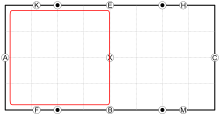
|
| Change through the whole web | |
| In this figure, the rider crosses the arena in a straight line from a corner, more precisely: from the change point after crossing the corner, to the diagonally opposite corner, more precisely: to the change point in front of the diagonally opposite corner. |

|
| Switch through half the web | |
| This figure is similar to the previous one, but the opposite long side is not reached at the changeover point , but in the middle and then turned away again towards the hoofbeat. |

|
| Switch through the length of the path | |
| Here, the path is crossed parallel to the long side from the middle of one short side to the middle of the opposite short side. The rider turns away in the middle of the short side, rides over the center of the path and turns back to the hoofbeat (riding) on the opposite short side . |

|
| Ridden through the length of the track | |
| In the middle of the short side, at point A or C, turn to the center line and ride straight on to the other short side. There again turned away on the same hand so not changed hands. |
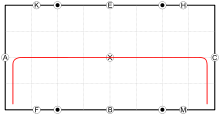
|
| Turns from the corner / Turns from the center | |
| On the left hand at path point K or M, and on the right hand at H or F. A (almost) three-quarter volte 6–10 meters in diameter is ridden in the corner, then with the horse straightened back at an oblique angle to the hoof beat. Depending on the level of training of horse and rider, the three-quarter volte will be ridden further or closer; then the figure ends sooner or later between the circle point and the middle of the long side - the straight line ends at a 30 to 45 degree angle on the hoof beat. |
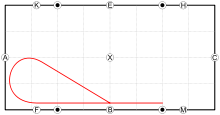
|
| Turns out of the corner | |
| You ride from E or B away from the hoofbeat to ride a volte in front of the short side and come back to the long side. | |
| Circle | |
| The compass is a circular orbit figure. The normal circle of 20 m diameter, with a track of 20 × 40 m in each half of the track, touches the hoofbeat (riding) at three points , namely in the middle of the short side as well as at the so-called circle points on the long sides of the track at the distance from the corners as half the short side is long. The fourth point is on the center line, in the center of the path. One speaks of the open and the closed circle side; the open one is the semicircle that does not touch the short side, the closed one the opposite. The middle circle is also common , in which the hoof beat is only reached at the two points in the middle of the long sides and the center is in the center of the riding arena. |

|
| Change from the circle | |
| This involves riding on a circle and changing hands in the middle of the open side of the circle (for a square 20 × 40 m above the center of the lane), then also riding a circle on the other hand. So two circles are ridden, which only touch at one point in the middle of the path. |
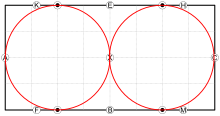
|
| Switch through the circle | |
| The rider is on a circle. At the circle point he turns away from the open side of the circle in half a volte, rides over the center point of the circle to the short side, changes hands over the center point and rides in another half volte on the new hand towards the other point of the circle; the rider describes an S-line within the circle, which leads from one circle point over a volte semicircle to the center point and over another volte semicircle on the new hand to the other circle point. |
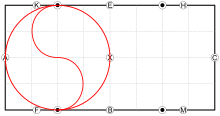
|
| Wavy lines on the long side, one or two arches | |
| With the simple serpentine line, after crossing the corner, the rider turns towards the long side from the change point inward and rides an arc into the path, you reach the middle of the side at a distance of 5 m, then turns in a slight arc the next corner at the turning point back on the hoofbeat. With the double serpentine line, two arcs with a maximum distance of 2.5 m from the gang are ridden from a change point, the horse returns after the first arc to the middle of the long side on the hoofbeat and then turns inward again to forward the corner at the change point to reach the hoofbeat again. Wavy lines are used for flexing gymnastics (by changing the position) of the horse. |
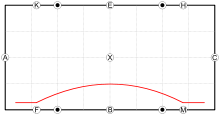
|
| Wavy lines through the whole track, three / four / five / six / seven arcs | |
| In this figure, the horse alternates between the long sides. The figure begins on the short side, the rider goes through the corner and then turns away parallel to the short side and rides at a right angle towards the opposite gang. A hand change is carried out when crossing the center line. When he has reached the other band or the opposite hoof beat, he rides a bow and returns to the start page in the same way. There are serpentines with three, four, five, six or seven arches (the latter in a square 20 × 60 m). |
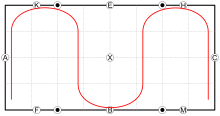
|
| The eight | |
|
In this figure an eight is ridden. If you start at the hoof stroke, only half a volte will be ridden, straighten the horse and change hands on the center line and ride a whole volte on this hand. On the middle line the horse is straightened again and a change of hands is ridden and the figure eight is ended with another half volte. |
|